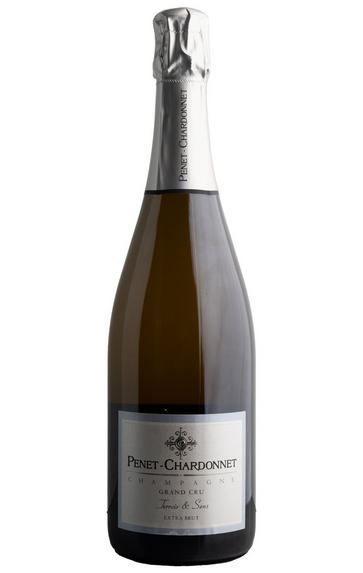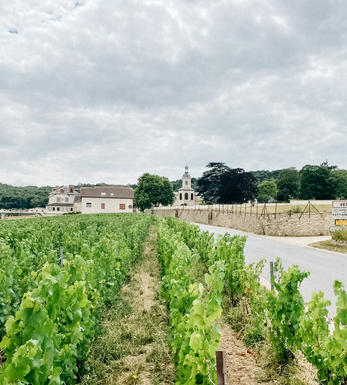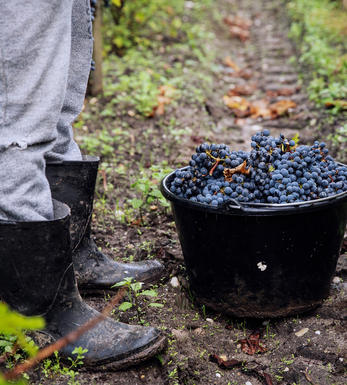
Champagne Penet-Chardonnet, Terroir & Sens, Grand Cru, Extra Brut

Critics reviews
70% Pinot Noir, 30% Chardonnay. Bottled May 2013, disgorged October 2021. Dosage 5.2 g/l.
Pale gold. It has a discreet nose, but the palate has more classic baked-apple fruit and attractive salinity. Balanced, lengthy and very savoury, leaning towards austere. That salty note becomes dominant on the finish.
Drink 2021 - 2031
Richard Hemming MW, JancisRobinson.com (February 2023)
Based on the 2012 vintage and disgorged in December 2020 with 5.2 grams per litre dosage, the NV Extra-Brut Grand Cru Terroir & Sens is showing well, revealing notions of crisp golden orchard fruit, dried white flowers and honeycomb, as well as hints of the biscuity complexity to come. Medium to full-bodied, rich and structured, with a concentrated core and chalky grip on the finish, this will benefit from at least a year or two more on the cork to unwind.
Drink 2023 - 2035
William Kelley, Wine Advocate (January 2022)
This has aromas of baked apple, grilled pineapple, lemon curd, toast, pie crust, cocoa and praline. Medium to full-bodied with silky bubbles and tangy acidity. Sleek and creamy. Excellent integration and balance. 70% Pinot Noir and 30% Chardonnay. 2012 base wine. 5.2g/l dosage.
Drink now
James Suckling, JamesSuckling.com (July 2022)
About this WINE

Champagne Penet-Chardonnet
Champagne Penet-Chardonnet has 400 years of winemaking history behind it. The estate spans six hectares, spread over 30 small plots across Verzy and Verzenay in the Montagne de Reims.
Located in the north-eastern extremity of the region, this land is 100% Grand Cru, and is home to some of the best Pinot Noir vineyards in all of Champagne. The Penet family farms their estate with the utmost care for nature, using sustainable and organic methods.
The estate is now run by fourth generation winemaker Alexandre Penet and his wife Martine, who have redefined the house style since taking over in 2009. Alexandre vinifies all crus separately, bottling the best sites as single lieu dits. These wines are set to become some of the most desired in the region: detail, expressive and made with precision, they are totally distinctive in personality.

Brut Champagne
Brut denotes a dry style of Champagne (less than 15 grams per litre). Most Champagne is non-vintage, produced from a blend from different years. The non-vintage blend is always based predominately on wines made from the current harvest, enriched with aged wines (their proportion and age varies by brand) from earlier harvests, which impart an additional level of complexity to the end wine. Champagnes from a single vintage are labelled with the year reference and with the description Millésimé.
Non-vintage Champagnes can improve with short-term ageing (typically two to three years), while vintages can develop over much longer periods (five to 30 years). The most exquisite and often top-priced expression of a house’s style is referred to as Prestige Cuvée. Famous examples include Louis Roederer's Cristal, Moët & Chandon's Dom Pérignon, and Pol Roger's Cuvée Sir Winston Churchill.
Recommended Producers : Krug, Billecart Salmon, Pol Roger, Bollinger, Salon, Gosset, Pierre Péters, Ruinart

Champagne blend
Which grapes are included in the blend, and their proportion, is one of the key factors determining the style of most Champagnes. Three grapes are used - Pinot Noir, Chardonnay and Pinot Meunier.
26% of vineyards in Champagne are planted with Chardonnay and it performs best on the Côtes des Blancs and on the chalk slopes south of Epernay. It is relatively simple to grow, although it buds early and thus is susceptible to spring frosts. It produces lighter, fresher wines than those from Burgundy and gives finesse, fruit and elegance to the final blend. It is the sole grape in Blancs de Blancs, which are some of the richest long-lived Champagnes produced.
Pinot Noir accounts for nearly 40% of the plantings in Champagne and lies at the heart of most blends - it gives Champagne its body, structure, strength and grip. It is planted across Champagne and particularly so in the southern Aube district.
The final component is Pinot Meunier and this constitutes nearly 35% of the plantings. Its durability and resistance to spring frosts make the Marne Valley, a notorious frost pocket, its natural home. It ripens well in poor years and produces a soft, fruity style of wine that is ideal for blending with the more assertive flavours of Pinot Noir. Producers allege that Pinot Meunier lacks ageing potential, but this does not deter Krug from including around 15% of it in their final blends.


Buying options
Add to wishlist
Description
This multi-vintage cuvée is sourced from Champagne Penet-Chardonnet’s finest sites, located across Verzy and Verzenay. Comprised of 70% Pinot Noir and 30% Chardonnay, the base wine is from the superlative 2013 vintage. This wine represents incredible value for the price: the nose is rich in white flowers and sourdough bread, while the palate is fine, smoky, and filled with mineral tension. The wine spent seven years on lees.
Drink 2023 - 2030
Davy Żyw, Senior Buyer, Berry Bros. & Rudd
wine at a glance
Delivery and quality guarantee